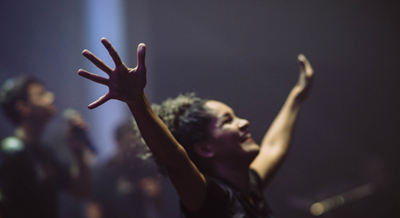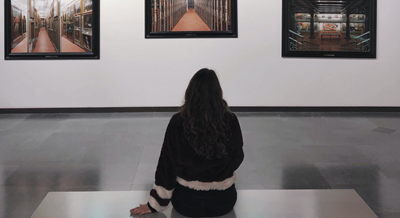
Positive outcomes are being observed from a dance-based quality initiative in St Patrick’s Mental Health Services (SPMHS).
Dance Movement Therapy (DMT) is currently being offered on the Dean Swift Ward in SPMHS, including its special care unit, as a quality initiative. A quality initiative is an activity or process which empowers service users, protects their rights, and/or improves their care and treatment experience.
Our Occupational Therapy Department, which organises the DMT quality initiative, has found the therapy brings a number of positive outcomes for service users.
What DMT is
DMT is the professional practice of psychotherapy through movement. It is not about learning dance steps; instead, the focus is on how it feels like to tune into the body and move creatively. It helps service users to develop their sense of body-mind connection, which can help them to manage their thoughts and emotions, and allows them to be creative and move in new ways. It is also an enjoyable activity, which is both energising and relaxing.
Moving is a central and basic part of daily life, which we can often take for granted. However, conscious movement can allow a person to experience a sense of integration and wholeness. A key concept in DMT is that our bodies and minds interact: a change in one will influence the other, and this has an effect on overall body-mind functioning.
In DMT sessions, service users and the therapist dance together to music; they dance to bring their whole selves into the healing process. The sessions start with a gentle warm-up and tuning into the body. This is followed by a more interactive part where service users can move as they choose. Finally, there is a wind down and relaxation at the end.
There are no dance techniques or steps to learn. Dancers move at their own pace, according to their energy levels. DMT can also be done in a seated position and adapted to people who have limited movement capacity or fitness.
Evidence base for DMT in mental health
DMT is informed by a wide range of psychology and psychotherapy approaches: embodiment, human development, creativity, and movement studies. It is used to treat a range of neurological, psychological, relationship, and social problems.
There is a growing evidence base for the effectiveness and mechanisms of change for DMT in mental health. Research has shown that DMT can reduce negative psychotic symptoms of schizophrenia, lessen depression symptoms, and ease dementia. DMT has also been shown to support people in addiction recovery and help people experiencing eating disorders by addressing underlying psychosocial factors, providing a safe space to explore relationships with the body, and improving coping skills. It is also a very effective way to experience relaxation and recuperation.
DMT on the Dean Swift Ward
DMT has been offered on the Dean Swift Ward since September 2023. It is led by a dance movement psychotherapist, Anna Fiona Keogh.
One 45-minute DMT group session is offered on Tuesday mornings in the Dean Swift Ward and its special care unit. These sessions are always very well attended. For example, out of 40 sessions provided in the first six-month period, only one session in the special care unit had no attendees.
In some instances, two or three short, individual DMP sessions are also offered on the special care unit if this is more appropriate to the needs of the service users on that day.
Aims and outcomes of DMT on the Dean Swift Ward
The DMT quality initiative was introduced in SPMHS with a number of key aims, which are seeing positive results as the initiative continues.
Grounding and a sense of safety in the bodies
DMT supports service users to get a sense of how they are today, in this present moment, and ‘gather themselves together.’ Service users are supported to get a sense of grounding and safety within their bodies through learning to centre themselves, self-manage their thoughts and emotions, and attend mindfully to their bodies and how they move.
Alleviation, or reduction, of pain
Dance is often very helpful in the easing of physical pain. Service users often find their own healing movements. This can be as simple as realising they are holding a lot of tension in the neck and shoulders and consciously exploring how to reduce this with head, neck and shoulder rolls or massage; or exploring how to let the movement flow and release tension.
Awareness of difficult feelings and externalisation of feelings
The DMT process allows unconscious thoughts to be brought into awareness in a safe, contained way. The thoughts can take form in different ways, such as words, an image, or a movement. In this way, service users can make sense and meaning out of their movement. For example, they become aware that they are stamping their feet or swinging their arms vigorously and that this is related to their frustration or anger at their situation. In this way, feelings are put into a movement, metaphor or symbol which supports their self-understanding and insight.
Vitality, energy and relaxation
Dancing boots energy levels and releases mood-enhancing chemicals in the body, such as endorphins and serotonin. Service users often mention that the sessions help them feel energised and encouraged to make the most of the day, yet a bit more relaxed also.
Experiences of joy, pleasure and relaxation
Dancing with other service users in the DMT session is often experienced as enjoyable and pleasurable, providing opportunities to laugh and share positive interactions with others.
Easing of feelings of isolation and shame
Dance movement is an act of creation with another person. This can reduce a sense of shame and isolation, and build connections with others, which are continued in day-to-day interactions on the ward.
Take-away practices
Service users are able to take away one or two very simple movement practices which they can do themselves. For example, service users can take away learnings like finding their balance or relaxing the body in various ways, or even simple practices like moving to music.
---
Anna Fiona Keogh has worked as a dance movement psychotherapist since she qualified with a Masters degree in Dance Movement Psychotherapy in Goldsmiths University of London in 2008. Currently, she provides DMT in mental health and addiction recovery settings, as well as in private practice.


